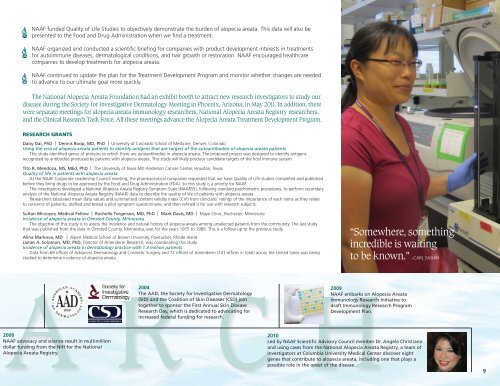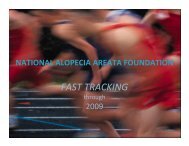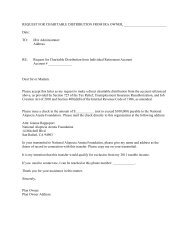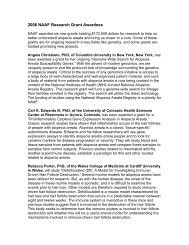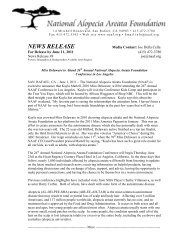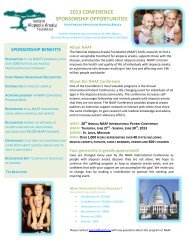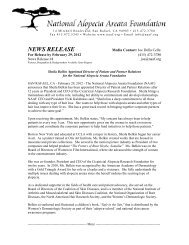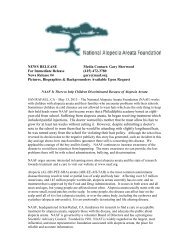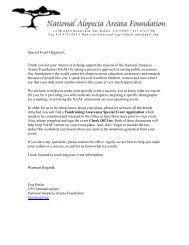2011 - National Alopecia Areata Foundation
2011 - National Alopecia Areata Foundation
2011 - National Alopecia Areata Foundation
You also want an ePaper? Increase the reach of your titles
YUMPU automatically turns print PDFs into web optimized ePapers that Google loves.
NAAF funded Quality of Life Studies to objectively demonstrate the burden of alopecia areata. This data will also be<br />
presented to the Food and Drug Administration when we find a treatment.<br />
NAAF organized and conducted a scientific briefing for companies with product development interests in treatments<br />
for autoimmune diseases, dermatological conditions, and hair growth or restoration. NAAF encouraged healthcare<br />
companies to develop treatments for alopecia areata.<br />
NAAF continued to update the plan for the Treatment Development Program and monitor whether changes are needed<br />
to advance to our ultimate goal more quickly.<br />
The <strong>National</strong> <strong>Alopecia</strong> <strong>Areata</strong> <strong>Foundation</strong> had an exhibit booth to attract new research investigators to study our<br />
disease during the Society for Investigative Dermatology Meeting in Phoenix, Arizona, in May <strong>2011</strong>. In addition, there<br />
were separate meetings for alopecia areata immunology researchers, <strong>National</strong> <strong>Alopecia</strong> <strong>Areata</strong> Registry researchers,<br />
and the Clinical Research Task Force. All these meetings advance the <strong>Alopecia</strong> <strong>Areata</strong> Treatment Development Program.<br />
RESEARCH GRANTS<br />
Daisy Dai, PhD | Dennis Roop, MD, PhD | University of Colorado School of Medicine, Denver, Colorado<br />
Using the sera of alopecia areata patients to identify antigens that are targets of the autoantibodies of alopecia areata patients<br />
This study identified genes of proteins to which there are autoantibodies in alopecia areata. The proposed project was designed to identify antigens<br />
recognized by antibodies produced by patients with alopecia areata. This study will likely produce candidate targets of the host immune system.<br />
Tito R. Mendoza, MS, MEd, PhD | The University of Texas MD Anderson Cancer Center, Houston, Texas<br />
Quality of life in patients with alopecia areata<br />
At the NAAF Corporate Leadership Council meeting, the pharmaceutical companies requested that we have Quality of Life studies completed and published<br />
before they bring drugs to be approved by the Food and Drug Administration (FDA). So this study is a priority for NAAF.<br />
The investigators developed a <strong>National</strong> <strong>Alopecia</strong> <strong>Areata</strong> Registry Symptom Scale (NAARSS), following standard psychometric procedures, to perform secondary<br />
analysis of the <strong>National</strong> <strong>Alopecia</strong> <strong>Areata</strong> Registry (NAAR) data to describe the quality of life of patients with alopecia areata.<br />
Researchers tabulated mean data values and summarized content validity index (CVI) from clinicians’ ratings of the importance of each items as they relate<br />
to concerns of patients, drafted and tested a pilot symptom questionnaire, and then refined it for use with research subjects.<br />
Sultan Mirzoyev, Medical Fellow | Rochelle Torgerson, MD, PhD | Mark Davis, MD | Mayo Clinic, Rochester, Minnesota<br />
Incidence of alopecia areata in Olmsted County, Minnesota<br />
The objective of this study is to assess the incidence and natural history of alopecia areata among unselected patients from the community. The last study<br />
that was published from the data in Olmsted County, Minnesota, was for the years 1975 to 1989. This is a follow-up to the previous study.<br />
Alina Markova, MD | Alpert Medical School of Brown University, Pawtucket, Rhode Island<br />
James A. Solomon, MD, PhD, Director of Ameriderm Research, was coordinating this study<br />
Incidence of alopecia areata in dermatology practice with 1.3 million patients<br />
Data from 69 offices of Advances Dermatology and Cosmetic Surgery and 72 offices of Ameriderm (141 offices in total) across the United Sates was being<br />
studied to determine incidence of alopecia areata.<br />
“Somewhere, something<br />
incredible is waiting<br />
to be known.” –CARL SAGAN<br />
A<br />
R2004<br />
C H<br />
2000<br />
NAAF advocacy and science result in multimillion<br />
dollar funding from the NIH for the <strong>National</strong><br />
<strong>Alopecia</strong> <strong>Areata</strong> Registry.<br />
The AAD, the Society for Investigative Dermatology<br />
(SID) and the Coalition of Skin Diseases (CSD) join<br />
together to sponsor the First Annual Skin Disease<br />
Research Day, which is dedicated to advocating for<br />
increased federal funding for research.<br />
2009<br />
NAAF embarks on <strong>Alopecia</strong> <strong>Areata</strong><br />
Immunology Research Initiative to<br />
draft Immunology Research Program<br />
Development Plan.<br />
2010<br />
Led by NAAF Scientific Advisory Council member Dr. Angela Christiano<br />
and using cases from the <strong>National</strong> <strong>Alopecia</strong> <strong>Areata</strong> Registry, a team of<br />
investigators at Columbia University Medical Center discover eight<br />
genes that contribute to alopecia areata, including one that plays a<br />
possible role in the onset of the disease.<br />
9


